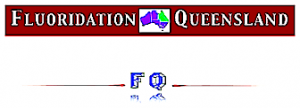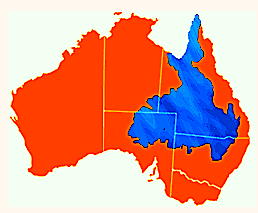
“…Artesian fluoride had the potential to affect work practices,
land values, animal husbandry, and wool economics adversely…”
The lethal dose of NaF (an industrial fluoride) is 50 times smaller than
that of CaF2 (the naturally-occurring fluoride) – Dr. Hardy Limeback,
Biochemist and Professor of Dentistry, University of Toronto,
a former consultant to the Canadian Dental Association.



‘CHRONIC ENDEMIC FLUOROSIS OF MERINO
SHEEP IN QUEENSLAND’
by
J. M. Harvey
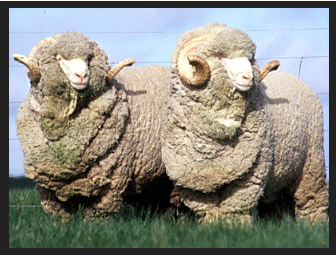
~ Original Queensland Government Research Documents ~
With assistance from The University of Queensland
PLEASE CLICK ON THE LINKS BELOW FOR BOOKS: (A), (B), or (C)
Vol. 9, No2 – June 1952

Vol. 10, No2 – June 1953

Vol. 10, No3 – September 1953

We apologise that there is other information in these booklets.
We suggest you read the document ‘EXEGESIS’ below, or better still
have a hard copy on hand while reading the three small books above.

The text, charts, photos and X ray presentations
in these research papers is all that is necessary to
condemn water fluoridation with no reservations!
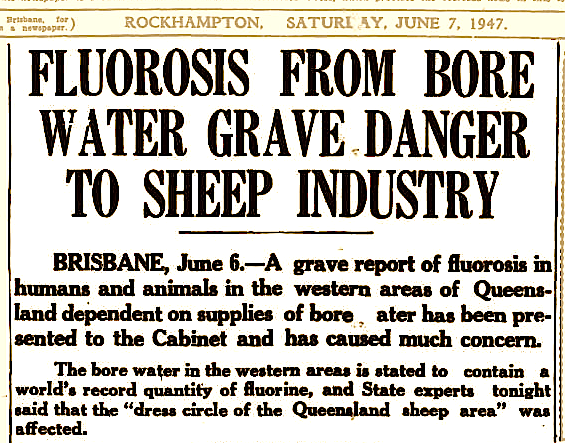
The Rockhampton ‘Morning Bulletin’ 7 June 1947 → HERE

Some Background Reading & Comments:
Credit – CSIRO PUBLISHING
The 1945–1955 Queensland Artesian Fluoride Experience
A Unique Phenomenon Within The Australian Wool Industry
by
Harry F. Akers and Suzette A. T. Porter
School of Dentistry, University of Queensland,
Brisbane, Australia.
Extract from thirteen pages.
Conclusion:
In the 1940s and 1950s, Queensland’s agricultural bureaucracy
instigated and supervised an investigation that was without precedent in
Australia in its rationale, geographical diversity, and commitment of
resources. Artesian fluoride had the potential to affect work practices,
land values, animal husbandry, and wool economics adversely.
As a result, the United Graziers’ Association, the Queensland Cabinet,
the state’s agricultural bureaucracy, veterinarians, and pastoralists
all viewed exposure of herds to fluoride as a serious and urgent issue.
The Department of Agriculture and Stock [now Primary Industries]
rapidly determined that there was no cure, but were able to manage
the problem by scientific investigation, methodical field study,
and the application of research findings to animal husbandry…
See also
The Fluoridation of Public Water Supplies Act (1963)
Why Not? – Timing, Circumstance,
A Review Of A Review
by Dr Harry Akers ↓


See also newspaper cutting → HERE
—— EXEGESIS ——
The three documents above A, B, and C,
reveal the nature of fluoride and some of its
impacts on living tissue, both animal and human.
This research has been out of print for many years and was funded by The Queensland Government.
It was undertaken without interference from multinational companies, and before artificial water fluoridation was under consideration. As can been seen on the charts, pages 11–16, in the first report, like India, China, Pakistan and much of the middle east, most of the artesian water in Queensland is not suitable for domestic use as it is high in fluorides. Although some of this water is very high in F, sheep do not live as long as humans, who will received a lesser dose under artificial water fluoridation but accumulating for 50 + years. Sheep also manufacture Vitamin C, unlike humans, which gives them some protection. The naturally-occurring fluoride CaF2 is far less toxic than the industrial wastes used to artificially fluoridate drinking water.
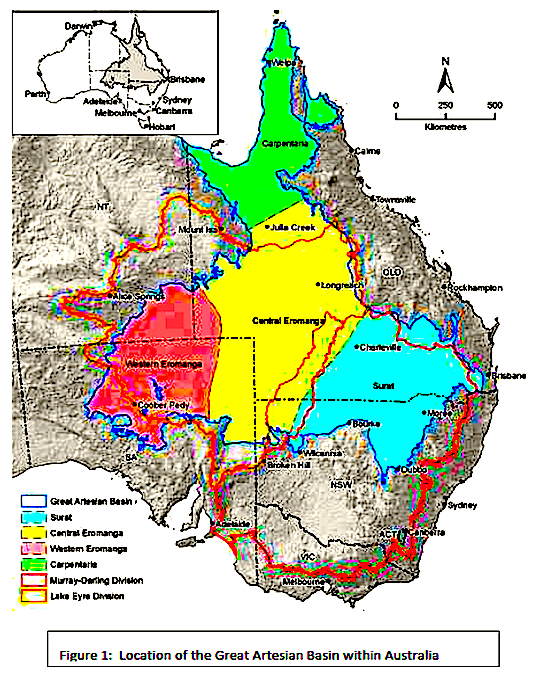
Highlights relative extracts to humans are presented below:
THE QUEENSLAND JOURNAL OF AGRICULTURAL SCIENCE
Vol. 9. – – No. 2 JUNE, 1952
~ CHRONIC ENDEMIC FLUOROSIS OF MERINO SHEEP IN QUEENSLAND ~
By J. M. HARVEY, M.Sc.,
Senior Chemist, Biochemical Section, Chemical Laboratory,
Division of Plant Industry.
The page numbers below are as per PDF listings
Page 11-16
Fluoride levels in Bores Throughout Queensland:
Page 21
… The possibility of fluorine excretion in milk of cows depastured in endemic areas of Queensland and confined to artesian water containing 7 p.p.m. F. was examined. The level of fluorine in the milk did not exceed 0.25 p.p.m …
Page 24
(1) Ewes on water containing up to 10 p.p.m. F. and irrespective of the quality of pasture or ration, do not excrete an increased amount of fluorine in the milk…
Our Comment:
Breast milk in humans is also low in F. even if mother is on a high F. diet.
Nature protects its young from F. especially at the beginning of life
when the blood brain barrier is not yet well formed. ~
Page 29
It has been reported that an insufficient supply or an imbalance of other inorganic constituents of the feed has been observed to influence the toxicity of ingested fluorine, while the addition of extra calcium phosphate to the ration has been reported to reduce the toxicity of calcium fluoride for sheep (Velu, 1933). Peirce (1939 stated that the toxic effect of fluorine is seemingly enhanced in poorly nourished sheep…
Our Comment:
This is why people on poor diets are also at greater risk when
drinking fluoridated water, and/or living in F. air pollution environments…~
Page 47
(1) There is some accumulation of fluorine in the kidney and thyroid.
Our Comment:
Same as humans, F. is antagonistic to iodine. (India and China) ~
Page 50
(1) All groups show a considerable fluorine concentration in bones and teeth as compared with that found in the normal control sheep.
Our Comment:
Same as humans ~
Page 77
These experimental findings support field experience, which suggests that the teeth lesions plus the accompanying pain prevent the sheep from collecting and mastication the feed. Thus the nutritional level is reduced and in its turn the yield of wool. Further field evidence lies in the fact that actual wool defects were not recorded in sheep in Queensland prior to 1941, when White, Moule, and Seddon looked for and found the dental lesions of fluorosis…
Upper and Lower Jaws of a Normal Animal
Abrasion of Molars and Premolars of Sheep Using Water Containing 5-7 p.p.m.
Fluorine and Depastured on Hard Mitchell Grass Country.
Note the compensating wear on the upper and lower molars and premolars.
Page 81 Fig. 86.
Three Examples of the Effect of Fluorine Intake Through
The Drinking Water on the Incisor Teeth of Sheep in Endemic Areas.
Left, Teeth from and animal following irregular intake of unsuitable water during its first year of life.
Centre, Teeth from a 6-tooth sheep on unsuitable water from an early age.
Right, Teeth from a sheep subjected to intermittent intake from unsuitable water during its growing period.
Page 84
(6) Teeth – Apart from the usual lesions associated with fluorosis, there are indications the fluorine in the drinking water delays the eruption of the incisors and produces badly deformed mouths. The elongation of the incisors and some abnormalities may be partly due to the type of feeding and mineral imbalance. There were, however, cases of delayed eruption and deformed mouths in groups 6 and 7, where the animals were on a balanced diet.
Our Comment:
Same as us humans
In their paper entitled “The failure of fluoridation in the United Kingdom”, when discussing the final report of that U.K. Health Department study, Professor A. Schatz and Dr J.J. Martin stated in 1972:
“It is thus clear that fluoridation does not prevent or reduce tooth decay. Instead, it merely postpones the appearance of caries by about 1.2 years. Fluoridated children develop the same amount of tooth decay as their non-fluoridated counterparts. The only difference is that caries starts developing approximately 1.2 years later in the fluoridated group.”
This delay, at least partly, could be due to the teeth of children in fluoridated areas erupting (breaking through the gums) at a slightly older age, and therefore being exposed to decay-producing factors for a shorter period… (as in Sheep) ~
Page 85
(7) Bones – The findings shown in the X-rays are not in keeping with those reported by other workers. All experimental groups showed rarification rather than thickening of the bones. This is particularly noticeable in the mandible, where the irregularities on the ventral border, formerly thought to be exostoses, have been shown to be due to a reduction in thickness of compact substance and the roots of the molars (and in some cases the premolars…
Page 89
4. Pregnant ewes drinking water containing up to 10 p.p.m. F. do not transmit appreciable quantities of fluorine either to the foetus or to the lamb through the milk after birth. However, although this procedure is safe with regard to the lamb, field evidence does suggest lower lambing figures in such ewes. In addition, water containing 10 p.p.m. is certainly harmful to young breeding ewes.
Our Comment:
Breast milk in humans is also low in F. even if mother is on a high F. diet. Nature protects its young from F. especially at the beginning of life when the blood brain barrier is not yet well formed.
Recent research suggests that the male of the species may not be so productive in F. environments.
Many people named and not named in the above research papers
deserve due acknowledgement, and so do the sheep
who gave their lives to this research.
Chairperson – Brisbane Anti-Fluoridation Association

Vitamin C or L-ascorbate is an essential nutrient for a large number of higher primate species, a small number of other mammalian species (notably guinea pigs and bats), a few species of birds, and some fish. ( Testing F. and drugs using rats and mice will yield erroneous results as these animals will manufacture more vitamin C to detoxify…
Laboratory guinea pigs cost more to maintain because
they need fresh food containing vitamin C…


More Research Info On F. And Sheep:
Proc. Aust. Soc. Anim. Prod. Vol. 16
THE BONE FLUORIDE OF EWES AND LAMBS IN N.S.W.
SALLY M. WHEELER* and ARNOLD D. TURNER*

-
↓ see also: ↓
by
A.W. Peirce. M.Sc.
Melbourne. 1938

Peirce, AW (CSIRO, 1954)
Three groups each of 16 mature sheep were allowed to graze on sown pasture for 26 months.
One group was given reservoir water, containing approximately 0.3 p.p.m. F, to drink, but the other two groups were offered similar …

Wheeler, SM; Turner, AD (ASAP, 1986)Proc. Aust. Soc. Anim. Prod. Vol. 16 THE BONE FLUORIDE OF EWES AND LAMBS IN N.S.W. SALLY M. WHEELER* and ARNOLD D. TURNER* SUMMARY Metatarsal bones of Border Leicester/Merino ewes (>4 y.o.) and lambs (~1 y.o.) were collected …

Peirce, AW (CSIRO, 1952)
Five groups, each of six sheep, were fed in pens on an adequate diet of chaffed hay and crushed grain for 3

Peirce, AW (CSIRO, 1959)
Three experimental groups of lambs were given water containing the same three different levels of fluorine, added as sodium fluoride, that their mothers had received during pregnancy and lactation. Group A (control), …



Research report
↓ Fluoride 45(3 Pt 2)247–250 July-September 2012 ↓


Most animals manufacture Vitamin C, in their livers,
which gives them some protection from fluoride damage.
BUT HUMAN LIVERS DO NOT HAVE THIS FUNCTION.
On poor diets humans will therefore
suffer more damage than most animals
even on lower doses.
❝…Vitamin C plays an important role in the orderly deposition
of fluoride into various tissues. In higher fluoride areas,
Vitamin C increases fluoride excretion and normalizes
soft and hard tissue fluoride levels and thus
prevents the development of fluorosis…”
~ Dr. John Yiamonyiannis ↓

‘Natural Fluoride’ – Calcium Fluoride CaF2
Is NOT Used To Artificially Fluoridate Water.
The chemicals mostly used to fluoridate drinking water are
waste products derived from the manufacture of phosphate fertilizer.
Sodium Fluorosilicate S6 and Fluorosilicic Acid S7
Fluorine is the most reactive, electronegative element and it’s never
found in nature as fluorine. There are many kinds of fluorides.
Calcium fluoride can be found naturally in water,
it is almost insoluble and can not be easily
absorbed by the body and therefor is not
as harmful as Fluorosilicic acid used to
artificially fluoridate drinking water.

TYPICAL ANALYSIS of FLUOROSILICIC ACID:
Nickel 1742. ppm
Aluminium 2.1 ppm
Cadmium 4. ppb
Arsenic 4826. ppb
Mercury 5. ppb
Chromium 3763. ppb
Lead 15. ppb

Fluoride is toxic and corrosive.
It rates ‘four’ on a one to five scale.
More toxic than lead,
slightly less toxic than arsenic.
While the uranium and radium in
fluorosilicic acid are known carcinogens,
two other products of Uranium
even more carcinogenic are:
These are also present in Fluorosilicic Acid.

Editor’s comment:
It looks like the animal sheep
get a better deal than the human sheep.
It may be better to get health advice from a vet,
rather than a doctor on the matter of fluoridation!


